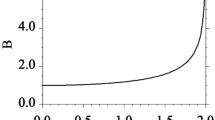Abstract
The general nonlinear Cosserat theory of a rod allows for tangential shear deformation, axial extension and a deformable cross-section. Simplified equations are obtained by introducing kinematic constraints and associated constraint responses which force the cross-section to remain rigid. The equations of motion of this constrained Cosserat rod are shown to be equivalent to those of Antman’s nonlinear special Cosserat theory of a rod. Strain measures motivated by the general Cosserat rod theory are used to develop explicit hyperelastic constitutive equations for the force and moment applied to the rod’s ends.

Similar content being viewed by others
References
Antman, S.S.: The theory of rods. In: Linear Theories of Elasticity and Thermoelasticity, pp. 641–703. Springer, Berlin (1973)
Antman, S.S.: Nonlinear Problems of Elasticity. Applied Mathematical Sciences, vol. 107. Springer, Berlin (1991)
Ericksen, J.L., Truesdell, C.: Exact theory of stress and strain in rods and shells. Arch. Ration. Mech. Anal. 1, 295–323 (1957)
Green, A.E., Naghdi, P.M., Wenner, M.L.: On the theory of rods. I. Derivations from the three-dimensional equations. Proc. R. Soc. Lond. Ser. A, Math. Phys. Sci. 337, 451–483 (1974)
Green, A.E., Naghdi, P.M., Wenner, M.L.: On the theory of rods II. Developments by direct approach. Proc. R. Soc. Lond. Ser. A, Math. Phys. Sci. 337, 485–507 (1974)
O’Reilly, O.M.: Modeling Nonlinear Problems in the Mechanics of Strings and Rods. Springer, Berlin (2017)
Rubin, M.B.: Cosserat Theories: Shells, Rods and Points. Springer Science & Business Media, vol. 79 (2000)
Acknowledgements
M.B. Rubin acknowledges partial support from his Gerard Swope Chair in Mechanics.
Author information
Authors and Affiliations
Corresponding author
Additional information
Publisher’s Note
Springer Nature remains neutral with regard to jurisdictional claims in published maps and institutional affiliations.
Appendix: Details of Some of the Developments
Appendix: Details of Some of the Developments
Within the context of the three-dimensional theory, the position vector \({\mathbf{X}}^{*}\) of a material point in the reference configuration and the position vector \({\mathbf{x}}^{*}\) of the same material point in the present configuration are proposed in the forms
where \(\theta ^{i}\) are convected coordinates through the rod’s cross-section and \(\theta ^{3}=S\). It then follows that the covariant base vectors \({\mathbf{G}}_{i}\) in the reference configuration and \({\mathbf{g}}_{i}\) in the present configuration are given by
Then, using the definitions (7) the three-dimensional deformation gradient \({\mathbf{F}}^{*}\) is given by
where \({\mathbf{G}}^{i}\) are the reciprocals of \({\mathbf{G}}_{i}\). This result shows that when the inhomogeneous deformation vectors \({\boldsymbol{\beta }}_{\alpha }\) vanish, \({\mathbf{F}}^{*}\) is independent of the coordinates through the rod’s cross-section.
Rights and permissions
About this article
Cite this article
Rubin, M.B. Equivalence of a Constrained Cosserat Theory and Antman’s Special Cosserat Theory of a Rod. J Elast 140, 39–47 (2020). https://doi.org/10.1007/s10659-019-09761-9
Received:
Published:
Issue Date:
DOI: https://doi.org/10.1007/s10659-019-09761-9




